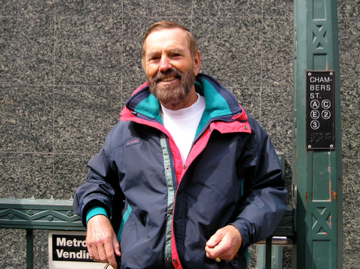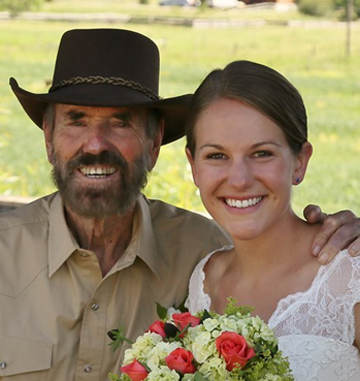
Curtis Ridling has been selected as a local Volunteer of the Month for his dedicated contributions to the Santa Barbara Triathlon
Curtis Ridling is confident he?ll be at his customary volunteer post at the intersection of Gobernador Canyon Road and Highway 192 for the cycling leg of the Santa Barbara Triathlon long-course route on Saturday, Aug. 24.
Ridling has been a fixture at that site for years, making sure triathletes are safe from oncoming traffic as they cross the highway.
For the important role he?s served with the Santa Barbara Triathlon, Presidio Sports is pleased to recognize Ridling as a local Volunteer of the Month.
The fact Ridling is talking about getting back on the course is nothing short of amazing.
Not long ago there was uncertainty on whether he would be alive today. Last December, while on a ski trip to Colorado, the 76-year-old cyclist, runner, skier and tennis player contracted the illness Sepsis and nearly died. Sepsis is a toxic response to an infection, or a poisoning of the blood. The infection, which was caused by a hernia, was in his intestinal tract.
He was so sick he couldn?t hold down any food or even stand.
?I rolled off the bed and crawled to the bathroom in my hotel room,? he said from his Santa Barbara home. ?The paramedics came to the room I was staying and there was this older guy who said, ?There?s an ambulance out there. You can get in it and we?ll take you to the hospital. It?s your call. But I got to tell you, if you don?t go, you?re not going to make it.?
?He was so right. I would have died in that room.?
VOLUNTEER OF THE MONTH
Volunteers often go under-recognized?even though they are extremely important to the?athletic community.?So important that many of the sporting events and organizations key to our lives wouldn’t be possible without those who donate their time to assist others.
Presidio Sports and Pacific Western Bank have joined forces to change that. This monthly spotlight series is our way of thanking those that selflessly give themselves for the benefit of many.
To all volunteers making a difference, we salute you.
He added: ?Lots of people saved my life along the way. I?m grateful for that.?

Curtis after running the Bolder Boulder 10k in 2010.
Ridling said he was in a coma for three weeks of a four-month stay in a Denver hospital. The illness affected his circulation. He had a blood clot removed from his right leg and later developed gangrene in his foot. Doctors amputated the toes on his right foot.
?It was like I had a stroke,? he explained. ?They took my toes, my right hand doesn?t work well. My right side got hammered, and it?s been hard recovery. It?s been one step forward and a step back.?
Nine months later, he is still fighting the illness. Recently, he developed an infection in his right foot, and he’s been on crutches.
But he hopes to be off of them and back directing traffic on perhaps the toughest volunteer assignment on the course.
?I told Joe (race director Joe Coito) the other day I want to do it again. Hopefully, I?m well enough to do it,? said Ridling.
As a long-time cyclist, Ridling feels the Gobernador Canyon-192 intersection is the best place for him.
?I request it every year,? he said.
On the 34-mile cycling route, outgoing riders make a left a turn off Hwy. 192 onto Gobernador Canyon, where they do a loop, exit onto Hwy 150 and head back onto Hwy 192 toward East Beach.
?It?s a bit of a sketchy spot,? he said. ?You got to block traffic coming and block the bikers because they can?t make a left turn (when there?s oncoming car traffic), and they have to follow the rules of the road. Everybody wants to make that left turn on to Gobernador without stopping.
?Sometimes I get yelled at by people because they think I?m a jerk because I?m making them stop.?
Ridling has plenty of experience keeping people in line. ?I taught high school for 30 years, I can be pretty bullish if I need to be,? he laughed.
In his early years at the intersection, Ridling said volunteers stopped the cars so the triathletes could make their left turn.
?We?d hold up the cars, but what went wrong with that was you?re holding up cars and behind them are (returning) bikers trying to get through who are ahead of the guys making a left by a good long ways. But they can?t go through because the cars are stopped. Sometimes they?d try and they?d go alongside the car.
?The police got on us about (the riders) have to obey the rules of the road. It?s actually safer for them to do what I did.?

Curtis saw his daughter Natalie married this summer. (Ronald Mathews Photo)
For several triathlons, Ridling worked the intersection with his daughter, Natalie.
Natalie has kept her father?s friends and family updated on his condition through the online site Caring Bridge (caringbridge.org).
Ridling’s page has received thousands of hits on the site.
?I?ve always been a stubborn, independent guy, but one of the lessons I learned from this is I needed people to help me,? he said, humbly.
Ridling credits his fitness with helping him survive the life-threatening illness.
?I?m a runner, still, and I?m a big bike rider ? I mostly do touring,? he told a reporter. ?I did a 1700-mile trip last summer: Glacier Park, down through the Tetons, Yellowstone, down to Salt Lake and over to Denver.
?That?s why I can talk to you, because I was in really good shape when this happened. It kept me from going under totally.?
He remains in good spirits, looking forward to the day when he can get back on his bike.
?One of these days I?m going to be back on my bike and rolling around. I know that?s going to happen, I just don’t know when.?
On working at a high-pressure point of the triathlon, Ridling said he wouldn?t have it any other way.
?It?s never quite the same. In some years, it?s pretty much cake, and some years it?s real hell,? he said. ?That?s OK. It?s a challenge to do and I kind of get a kick out of the challenge. That?s why I like to give back.
?There?s way too many guys for many years that did things to keep me safe.?




